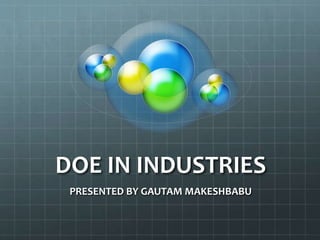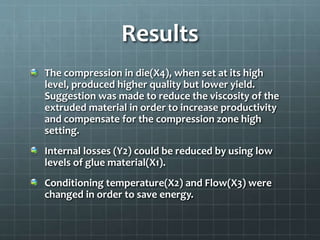doe in other industries
- 1. DOE IN INDUSTRIES PRESENTED BY GAUTAM MAKESHBABU
- 2. OVERVIEW Why DOE?-The basic goal How can DOE help industries? Case studies âĒ Problems âĒ Factors and response âĒ Experimental run âĒ Conclusions
- 3. WHY DOE? Quality and Reliability Early stage implementation Wide use Not limited to manufacturing industries
- 4. DOE IN INDUSTRIES Comparisons Variable screenings Transfer function exploration System optimization System robustness
- 5. CASE STUDY EXPERIMENTAL DESIGN IN A PET FOOD MANUFACTURING COMPANY
- 6. PROCESS OF MANUFACTURE DECIDE THE FORMULA MIXING AND CONDITIONING EXTRUDING AND CUTTINGs COOLING AND DRYING 1.1 Decide the ingredients. 1.2 Proportion of each ingredient 1.3 Value of PQF (glue material) 2.1 Weight 2.2 Mix 2.3 Set temperature of water steam 2.4 Add water steam to mixture 3.1 Extrude the mixture through a metallic die 3.2 Cut the extruded material in small cylinders 4.1 Small cylinders of rabbit chow on conveyor belt are cooled and dried with air 4.2 Packaging
- 7. PROBLEMS FACED During the cooling and drying of the rabbit food cylinders, a loss of product in the form of powder was taking place. During manipulation and transportation, the cylinders eroded and formed fine powder. This created loss of product and also digestion problems in rabbits.
- 8. IN THE PAST When quality deteriorated, the following steps were taken in order to maintain the quality of the yield. âĒ Reduce flow of mixture in extrusion. low yield âĒ Raise conditioning temp in mixture. High energy consumption âĒ Change compression temp in die. Time consuming âĒ Last resort- change formula by adding glue material.
- 9. FACTORS AND LEVELS LEVELS FACTOR - + FORMULA (PQF) 10 20 CONDITIONING TEMPERATURE (T) 80% of T T (max) FLOW (F) 80% of F F (max) COMPRESSION ZONE IN DIE 2â 2 Â―â CONSTRAINTS: All experiments should be performed in a single day. All activities must be done inside the plant. Factor 4(compression zone in die) cant be changed easily.
- 10. EXPERIMENTAL DESIGN Y1- Powder in product Y3- Yield Y2- Powder in process Y4- Energy consumption RANDOM ORDER RUN NUMBER FACTORS X1 X2 X3 X4 RESPONSES Y1 Y2 Y3 Y4 12 1 - + - + 0.916 1.92 7.50 222.5 9 2 + - - - 1.178 2.07 8.70 238.0 3 3 - + + - 1.216 1.85 10.2 250.4 4 4 + - + + 1.119 2.03 6.20 250.4 1 5 - - - - 1.315 1.66 8.3 235.0 10 6 + + - + 0.911 2.08 7.20 222.0 11 7 - - + + 1.07 1.96 7.95 267.5 2 8 + + + - 1.273 2.13 9.6 248.2 8 9 - + - - 1.071 1.62 8.50 224.0 6 10 + - - + 1.025 1.73 5.90 233.3 5 11 - + + + 1.04 1.64 7.3 248.5 7 12 + - + - 1.174 1.93 9.95 255.0
- 11. 0.20.10.0-0.1-0.2 99 95 90 80 70 60 50 40 30 20 10 5 1 Effect Percent A x1 B x2 C x3 D x4 Factor Name Not Significant Significant Effect Type Normal Plot of the Effects (response is y1, Alpha = 0.05) Lenth's PSE = 0.093 0.20.10.0-0.1-0.2 99 95 90 80 70 60 50 40 30 20 10 5 1 Effect Percent A x1 B x2 C x3 D x4 Factor Name Not Significant Significant Effect Type ACD AB A Normal Plot of the Effects (response is y2, Alpha = 0.05) Lenth's PSE = 0.06375 210-1-2-3 99 95 90 80 70 60 50 40 30 20 10 5 1 Effect Percent A x1 B x2 C x3 D x4 Factor Name Not Significant Significant Effect Type D Normal Plot of the Effects (response is y3, Alpha = 0.05) Lenth's PSE = 0.76875 2520151050-5-10 99 95 90 80 70 60 50 40 30 20 10 5 1 Effect Percent A x1 B x2 C x3 D x4 Factor Name Not Significant Significant Effect Type C Normal Plot of the Effects (response is y4, Alpha = 0.05) Lenth's PSE = 4.6875
- 12. 1-1 1.20 1.15 1.10 1.05 1.00 1-1 1-1 1.20 1.15 1.10 1.05 1.00 1-1 x1 Mean x2 x3 x4 Main Effects Plot for y1 Data Means 1-1 2.00 1.95 1.90 1.85 1.80 1-1 1-1 2.00 1.95 1.90 1.85 1.80 1-1 x1 Mean x2 x3 x4 Main Effects Plot for y2 Data Means 1-1 9.0 8.5 8.0 7.5 7.0 1-1 1-1 9.0 8.5 8.0 7.5 7.0 1-1 x1 Mean x2 x3 x4 Main Effects Plot for y3 Data Means 1-1 250 245 240 235 230 1-1 1-1 250 245 240 235 230 1-1 x1 Mean x2 x3 x4 Main Effects Plot for y4 Data Means
- 13. Results The compression in die(X4), when set at its high level, produced higher quality but lower yield. Suggestion was made to reduce the viscosity of the extruded material in order to increase productivity and compensate for the compression zone high setting. Internal losses (Y2) could be reduced by using low levels of glue material(X1). Conditioning temperature(X2) and Flow(X3) were changed in order to save energy.
- 14. Another Example Goal: Find the factors that affect the gain in a earphone. Factors: âĒ Width of lines(W) âĒ Resistance(R) âĒ Capacitance(C) Response: Gain(dB)
- 15. W R C Gain 0 0 0 13.88 -1 1 -1 14.52 1 -1 -1 13.01 1 -1 1 13.09 -1 1 1 14.61 -1 -1 1 12.93 -1 -1 -1 12.85 1 1 1 14.81 1 1 -1 14.71 Factor Low High W(um) 9.5o 10.50 R(ohm) 30.4 33.6 C(pF) 19 21 Factors and levels W= 10Âą0.5 um R= 32Âą1.6 ohm C= 20Âą1 pF
- 16. 1.81.61.41.21.00.80.60.40.20.0 99 95 90 80 70 60 50 40 30 20 10 5 1 Effect Percent A Width of lines B Resistance C Capacitance Factor Name Not Significant Significant Effect Type C B A Normal Plot of the Effects (response is Gain, Alpha = 0.05) Lenth's PSE = 0.0075
- 17. Main Effects 1-1 14.5 14.0 13.5 13.0 1-1 1-1 14.5 14.0 13.5 13.0 Width of lines Mean Resistance Capacitance Main Effects Plot for Gain Data Means
- 18. Factorial Fit: Gain versus Width of lines, Resistance, Capacitance Term Effect Coef Constant 13.8163 Width of lines 0.1775 0.0888 Resistance 1.6925 0.8463 Capacitance 0.0875 0.0437 Width of lines*Resistance 0.0175 0.0088 Width of lines*Capacitance 0.0025 0.0012 Resistance*Capacitance 0.0075 0.0037 Width of lines*Resistance* 0.0025 0.0012 Capacitance Gain= 13.81+ 0.088W+ 0.8463R+ 0.8463C+ 0.0088W*R+ 0.0012W*C+ 0.0037R*C+ 0.0012W*R*C
- 19. Management & Service Industries Analysis to find the factors that affect the acceptance of presentations. Done by an ISRU(In-site Resource utilization) Question: How can we improve the showcase in order to make it more resourceful to the members. Methodology: Questionnaires and ranking. Factors: Presentation Content (General or specific) Number of speakers(Single or Multiple) Timing of showcase(morning or afternoon) Response: Rank(average rank given by members)
- 20. FACTORS LEVELS PRESENTATION CONTENT Specific case studies General Overview NUMBER OF SPEAKERS One speaker Multiple speakers TIMING OF THE SHOWCASE Morning Afternoon Option Presentation Content Number of Speakers Timing of the showcase Rank 1 Specific Case Studies Multiple Speakers Afternoon 5.1 2 General Overview One Speaker Afternoon 4.9 3 Specific Case Studies One Speaker Morning 5.0 4 General Overview Multiple Speakers Afternoon 4.5 5 Specific Case Studies One Speaker Afternoon 6.1 6 General Overview Multiple Speakers Morning 4.3 7 General Overview One Speaker Morning 3.3 8 Specific Case Studies Multiple Speakers Morning 2.8
- 21. timingspeakerscontent lunch morning multiple single cases general 5.2 4.9 4.6 4.3 4.0 mean Main Effects Plot (data means) for mean
- 22. Estimated Effects and Coefficients for rank (coded units) Term Effect Coef Constant 4.5000 presentation content -0.7500 -0.3750 no of speakers -1.2000 -0.6000 timing -0.7500 -0.3750 presentation content*no of speakers 0.2500 0.1250 presentation content*timing -0.4000 -0.2000 no of speakers*timing -0.9500 -0.4750 presentation content*no of speakers* 0.4000 0.2000 timing general cases multiplemultiplesinglesingle 5.5 5.0 4.5 4.0 3.5 3.0 speakers content Mean Interaction Plot (data means) for mean
- 23. Conclusions made âĒ The audience prefer to have multiple speakers overall as the mean rank scores are higher for multiple than for single speakers. âĒ They feel more strongly that they prefer multiple speakers if the content is general, but are not so bothered if the content is case studies. âĒ The audience preferred an afternoon presentation as a whole but specifically wanted afternoon for case studies. 1-1 5.25 5.00 4.75 4.50 4.25 4.00 3.75 3.50 timing Mean -1 1 content presentation Interaction Plot for rank Data Means
- 24. Factors Levels Application type Loan Lease Region Midwest Northeast Description Current Enhanced Example Current Enhanced Neg. Example Yes None DOE in Financial Operations Problem: 60% reprocessing rate of applications. Main reason: Incomplete information provided by customer
- 26. 403020100 99 95 90 80 70 60 50 40 30 20 10 5 1 Effect Percent A Application type B Region C Description D Example E Neg example Factor Name Not Significant Significant Effect Type D C Normal Plot of the Effects (response is Avg % completed, Alpha = 0.05) Lenth's PSE = 1.8
- 27. LeaseLoan 90 80 70 60 50 NortheastMidwest EnhancedCurrent EnhancedCurrent 90 80 70 60 50 NoneYes Application type Mean Region Description Example Neg example Main Effects Plot for Avg % completed Data Means
- 28. NortheastMidwest EnhancedC urrent EnhancedC urrent NoneYes 100 75 50 100 75 50 100 75 50 100 75 50 A pplication type Region Description Example Neg example Loan Lease type Application Midwest Northeast Region Current Enhanced Description Current Enhanced Example Interaction Plot for Avg % completed Data Means
- 29. NoneYes 74 73 72 71 70 69 68 Neg example Mean Midwest Northeast Region Interaction Plot for Avg % completed Data Means Conclusions made: âĒ Provide enhanced descriptions and examples. âĒ Neg. examples were stopped in the Northeast region. Results: âĒ Reprocessing rates reduced to 5%. âĒ Reduced cycle time for application processing. âĒ Increase in profit without increasing customers.
- 30. Reference âĒ http://en.wikipedia.org/wiki/Design_of_experiments âĒ http://www.ese.wustl.edu/~psm/405quality-control- article.pdf âĒ http://www.obgyn.cam.ac.uk/cam- only/statsbook/stexdes.html âĒ http://www.iaeng.org/publication/WCE2007/WCE2007_pp 1108-1112.pdf
- 31. Thank You






























